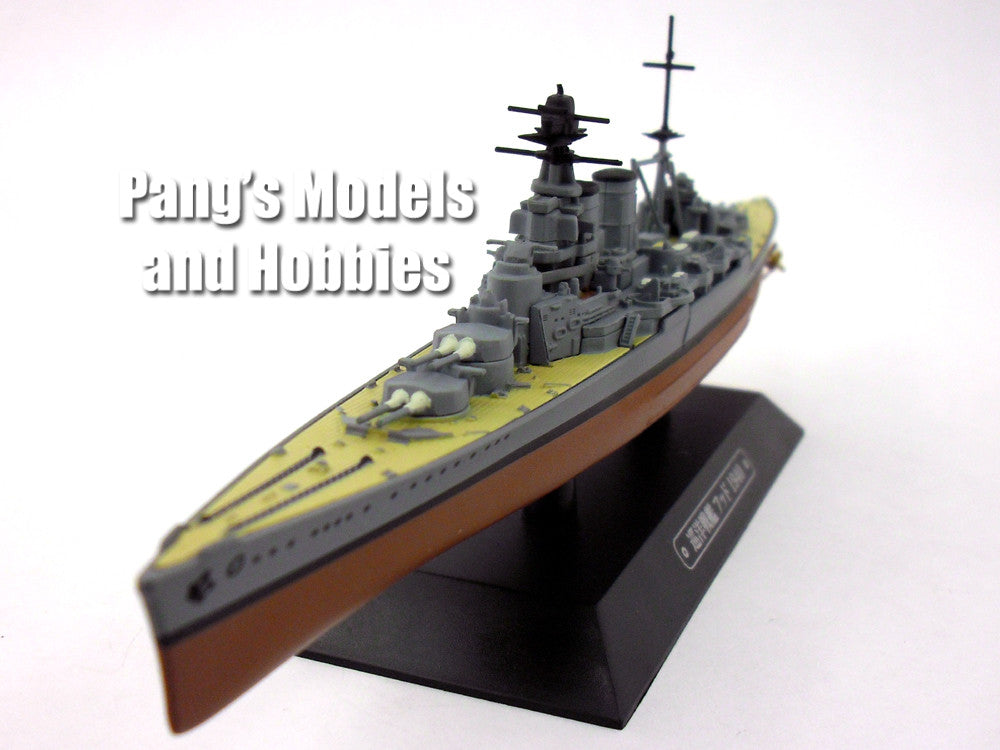Battlecruiser HMS Hood 1/1100 Scale Diecast Metal Model Ship by Eaglemoss
$ 34.99
FREE SHIPPING IN THE US AND US TERRITORIES
1/1100 Scale Battlecruiser HMS Hood: Length: 9", Width: 1.5"
Warships of the World collection from Eaglemoss is a breakthrough for both military and maritime enthusiasts. Each has details and features that even the most discriminating collectors will appreciate:
- A consistent 1:1100 scale that makes for a stunning display, with each ship visually comparable to all the others in the collection.
- Heavy-duty metal construction with finely molded plastic detail parts. Miniature aircraft with cranes, detailed guns with blast bags, and a complete superstructure.
- Textured surfaces that simulate wooden decks, intricate ironwork, chains and cleats.
- Accurate colors and markings, from anti-fouling paint on the hulls to camouflage patterns, national insignia (including roundels on aircraft), and even runway markings.
- A removable, customized display stand with the ship's name (in Japanese) and year.
HMS Hood (pennant number 51) was the last battlecruiser built for the Royal Navy. Commissioned in 1920, she was named after the 18th-century Admiral Samuel Hood. One of four Admiral-class battlecruisers ordered in mid-1916, Hood had serious design limitations, though her design was drastically revised after the Battle of Jutland and improved while she was under construction. For this reason she was the only ship of her class to be completed.
As one of the largest and, ostensibly, the most powerful warships in the world, Hood was the pride of the Royal Navy and, carrying immense prestige, was known as ‘The Mighty Hood’.
Hood was involved in several showing the flag exercises between her commissioning in 1920 and the outbreak of war in 1939, including training exercises in the Mediterranean Sea and a circumnavigation of the globe with the Special Service Squadron in 1923 and 1924. She was attached to the Mediterranean Fleet following the outbreak of the Second Italo-Abyssinian War. When the Spanish Civil War broke out, Hood was officially assigned to the Mediterranean Fleet until she had to return to Britain in 1939 for an overhaul. By this time, advances in naval gunnery had reduced Hood 's usefulness. She was scheduled to undergo a major rebuild in 1941 to correct these issues, but the outbreak of World War II in September 1939 forced the ship into service without the upgrades.
When war with Germany was declared, Hood was operating in the area around Iceland, and she spent the next several months hunting between Iceland and the Norwegian Sea for German commerce raiders and blockade runners. After a brief overhaul of her propulsion system, she sailed as the flagship of Force H, and participated in the destruction of the French Fleet at Mers-el-Kebir. Relieved as flagship of Force H, Hood was dispatched to Scapa Flow, and operated in the area as a convoy escort and later as a defence against a potential German invasion fleet.
In May 1941, she and the battleship Prince of Wales were ordered to intercept the German battleship Bismarck and theheavy cruiser Prinz Eugen, which were en route to the Atlantic where they were to attack convoys. On 24 May 1941, early in the Battle of the Denmark Strait, Hood was struck by several German shells, exploded and sank. Due to her perceived invincibility, the loss had a profound effect on the British people.














